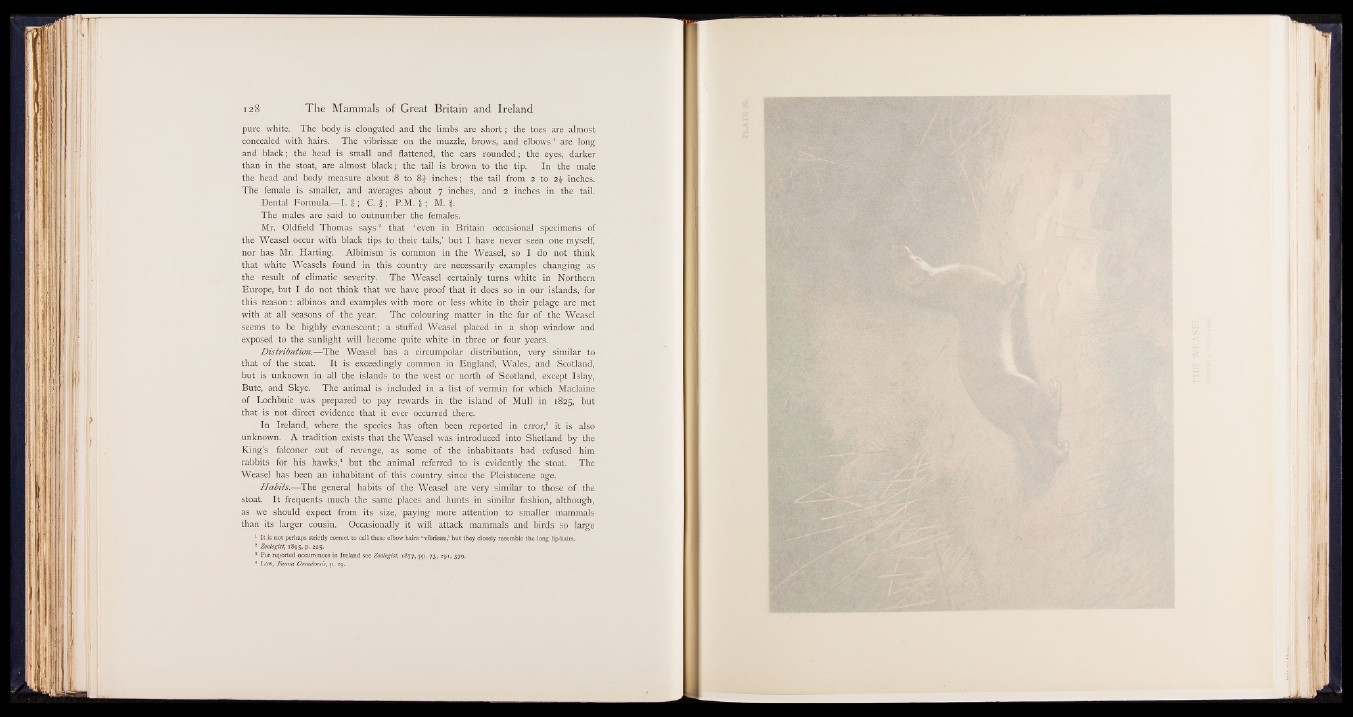
pure white. The body is elongated and the limbs are short; the toes are almost
concealed with hairs. The vibrissas on the muzzle, brows, and elbows1 are long
and black; the head is small and flattened, the ears rounded; the eyes, darker
than in the stoat, are almost black; the tail is brown to the tip. In the male
the head and body measure about 8 to 8£ inches; the tail from 2 to 2 \ inches.
The female is smaller, and averages about 7 inches, and 2 inches in the tail.
Dental Formula.— I. f ; C. # ; P.M. f ; M. f.
The males are said to outnumber the females.
Mr. Oldfield Thomas says2 that ‘ even in Britain occasional specimens of
the Weasel occur with black tips to their tails,’ but I have never seen one myself,
nor has Mr. Harting. Albinism is common in the Weasel, so I do not think
that white Weasels found in this country are necessarily examples changing as
the result of climatic severity. The Weasel certainly turns white in Northern
Europe, but I do not think that we have proof that it does so in our islands, for
this reason: albinos and examples with more or less white in their pelage are met
with at all seasons of the year. The colouring matter in the fur of the Weasel
seems to be highly evanescent; a stuffed Weasel placed in a shop window and
exposed to the sunlight will become quite white in three or four years.
D istribution.—The Weasel has a circumpolar distribution, very similar to
that of the stoat. It is exceedingly common in England, Wales, and Scotland,
but is unknown in all the islands to the west or north of Scotland, except Islay,
Bute, and Skye. The animal is included in a list of vermin for which Maclaine
of Lochbuie was prepared to pay rewards in the island of Mull in 1825, but
that is not direct evidence that it ever occurred there.
In Ireland, where the species has often been reported in error,8 it is also
unknown. A tradition exists that the Weasel was introduced into Shetland by the
King’s falconer out of revenge, as some of the inhabitants had refused him
rabbits for his hawks,4 but the animal referred to is evidently the stoat. The
Weasel has been an inhabitant of this country since the Pleistocene age.
H abits.—The general habits of the Weasel are very similar to those of the
stoat. It frequents much the same places and hunts in similar fashion, although,
as we should expect from its size, paying more attention to smaller mammals
than its larger cousin. Occasionally it will attack mammals and birds so large
1 It is not perhaps strictly correct to call these elbow hairs ‘ vibrissas,’ but they closely resemble the long lip-hairs.
* Zoologist, 1895, p. 225.
8 For reported occurrences in Ireland see Zoologist, 1877, pp. 73, 291, 379.
4 Low, Fauna Oreadensis, p. 29.